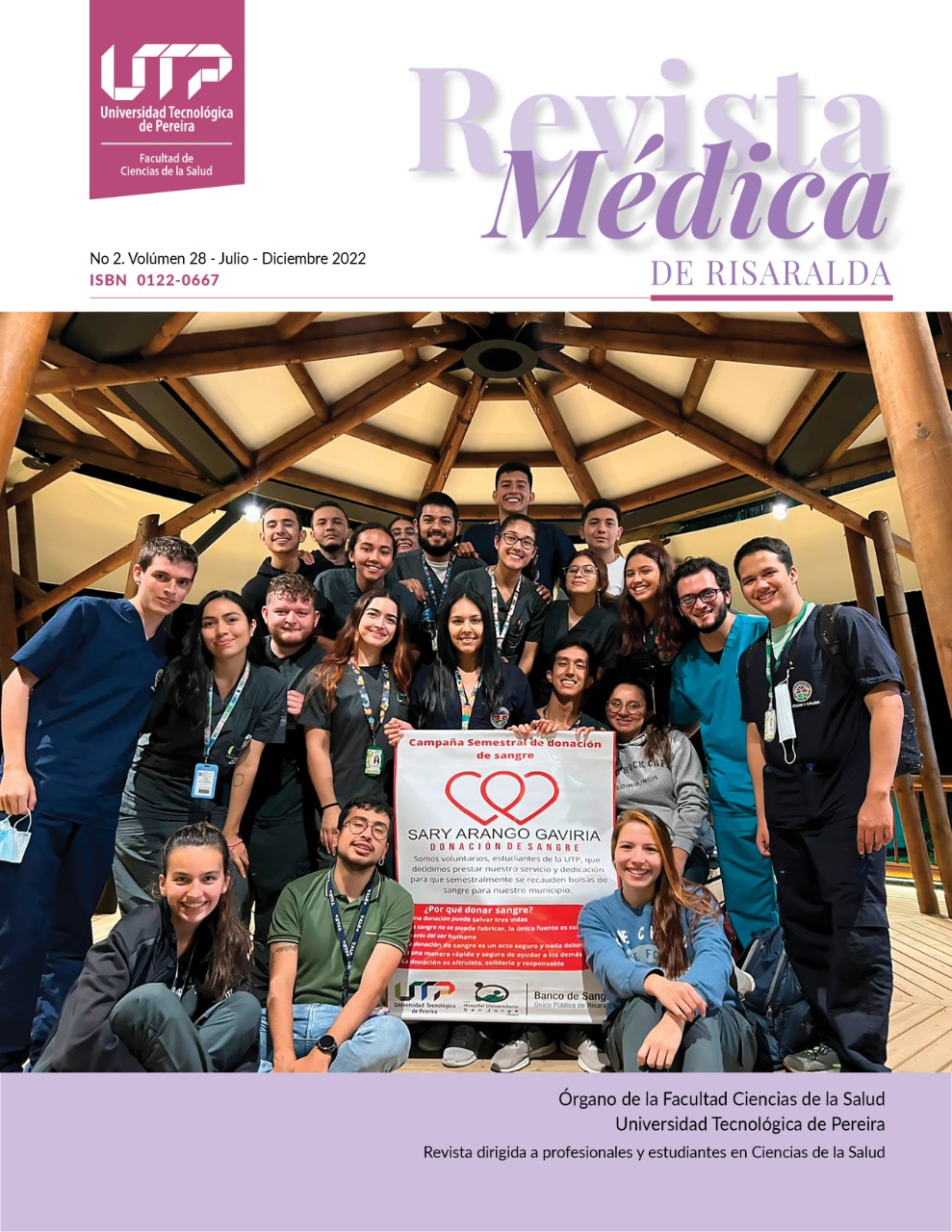Physio-prophylaxis post-stress test in soccer players: effects blood lactate concentrations
Post-stress physioprophylaxis test in soccer players: effects of blood lactate concentrations
DOI:
https://doi.org/10.22517/25395203.24986Keywords:
Muscle, fatigue, physio-prophylaxis, soccer, lactateAbstract
Objective: To determine the effects of physioprophylaxis (PP) on blood lactate (BL) concentrations after maximal incremental stress test, considering that this is the application of techniques in sports physiotherapy to reduce signs of muscle fatigue that can trigger injuries due to overload.
Materials and Methods: Quantitative study, experimental type, longitudinal section in 12 university players. The group is divided into one control group (CG) with recovery at rest without PP and another experimental group (EG) to which PP is applied at the end of the test. Blood lactate is recorded with Accutrend Plus at the beginning of the test, (1) five minutes after finishing the test (2) and after the PP (3) at two different moments for intra-subject analysis.
Results: The following data were obtained regarding blood lactate clearance, Moment 1: Without Plan (WoP) 4.86±1.4 and With Plan (WP) 8.85±1.25 (p<0.05), moment 2: (WoP) 5.6±1.76 and (WP) 7.8±1.3 (p<0.05) in mmol/L, and intra-subject: (WoP): 5.25±1.58; (WP): 8.35±1.33 (p<0.05).
Conclusions: The clearance of lactate in the blood at 30 minutes post stress test in the EG is bigger than the CG, because they recovered with the physioprophylactic plan.
Downloads
References
Izquierdo M. Biomechanics and Neuromuscular Bases of Physical Activity and Sport. Madrid: Medica panamericana; 2008.
Gómez-Campos, R.; Cossio-Bolaños, M.A.; Brousett Minaya, M. y Hochmuller-Fogaca RT. The mechanisms involved in acute fatigue. Int J Med Sci Phys Act Sport. 2010;10(40):537-55.
Giraldo JC, Sánchez ME. El lactato como posible factor del mecanismo de fatiga muscular. Colomb Med. 1998;29(3):87-91.
Manrique-Abril FG, Quintero Burgos RI, Herrera Amaya GM. Blood lactate from salivary biomarkers. A study with physiological indicators in cyclists from the city of Tunja (Colombia) during stress test. Arch Med. 15 de agosto de 2017;17(2):379-90.
Quintero-Burgos RI M-AF. The blood lactate and its correlation with salivary biomarkers as indicators of exercise intensity. Rev.salud.hist.sanid.on-line. 2011;6(2):3-11.
Goodwin ML, Harris JE, Hernández A, Gladden LB. Blood lactate measurements and analysis during exercise: A guide for clinicians. J Diabetes Sci Technol. 2007;1(4):558-69.
Wilmore, J. Costill D. Fisiología del esfuerzo y del deporte. Madrid: Paidotribo; 2014. 688 p.
Bangsbo J, Mohr M, Krustrup P. Physical and metabolic demands of training and match-play. J Sports Sci. 2006;24(7):665-74.
Urdampilleta A, Armentia I, Gómez S. Muscle fatigue in athletes: Physical, nutritional and pharmacological methods for improving recovery. Arch Med del Deport. 2015;32(1):36-43.
Cos, Francesc; Cos, Miquel Ángel; Buenaventura, Lorenzo; Pruna, Ricard. & Ekstrand J. Analysis models for the prevention of sports injuries. Epidemiological study of injuries: The UEFA model in football. Apunt Med l’Esport. 2010;45(166):95-102.
Kubinska Z, Mysula. I, Zaworski K, Pocztarska-Głos A. Physioprophylaxis in Physiotherapy with Emphasison Physical Activity. Galician Med J. 2019;26(2):E201923-7.
Serrato M. Medicina del deporte. Editorial Universidad del Rosario.; 2008.
Hilario Moreno B, Ramos Bermúdez S, Alonso Alzate D. Recovery media an interdisciplinary work in the coaches attending the south American Games Medellín 2010 (Colombia). Salud UNINORTE [Internet]. 2013 [citado 11 de septiembre de 2019];29(1):42-51. Disponible en: http://www.scielo.org.co/scielo.php?pid=S0120-55522013000100006&script=sci_arttext&tlng=pt
McAinch AJ, Febbraio MA, Parkin JM, Zhao S, Tangalakis K, Stojanovska L, et al. Effect of Active Versus Passive Recovery on Metabolism and Performance during Subsequent Exercise. Int J Sport Nutr Exerc Metab [Internet]. 2004 [citado 11 de septiembre de 2019];14(2):185-96. Disponible en: https://journals.humankinetics.com/view/journals/ijsnem/14/2/article-p185.xml
Mohr M, Krustrup P, Bangsbo J. Fatigue in soccer: A brief review. Vol. 23, Journal of Sports Sciences. 2005. p. 593-9.
Krustrup P, Mohr M, Steensberg A, Bencke J, Klær M, Bangsbo J. Muscle and blood metabolites during a soccer game: Implications for sprint performance. Med Sci Sports Exerc [Internet]. 2006 [citado 11 de septiembre de 2019];38(6):1165-74. Disponible en: https://europepmc.org/abstract/med/16775559
Monedero J, Donne B. Effect of recovery interventions on lactate removal and subsequent performance. Int J Sports Med. 2000;21(8):593-7.
Kinugasa T, Kilding AE. A comparison of post-match recovery strategies in youth soccer players. J Strength Cond Res [Internet]. 2009 [citado 11 de septiembre de 2019];23(5):1402-7. Disponible en: www.nsca-jscr.org
Ferrari HG, Oliveira R, Strapasson MV, Santa Cruz RAR, Libardi CA, Cavaglieri CR. Efeito de diferentes méto dos de recuperação sobre a remoção de lact ato e desempenho anaeróbio de futebolistas. Rev Bras Med do Esporte. noviembre de 2013;19(6):423-6.
Published
Versions
- 2022-12-27 (5)
- 2022-12-27 (4)
- 2022-12-21 (3)
- 2022-11-26 (2)
- 2022-10-30 (1)
How to Cite
Issue
Section
License
Cesión de derechos y tratamiento de datos
La aceptación de un artículo para su publicación en la Revista Médica de Risaralda implica la cesión de los derechos de impresión y reproducción, por cualquier forma y medio, del autor a favor de Facultad de Ciencias de la Salud de la Universidad Tecnológica de Pereira. 1995-2018. Todos los derechos reservados ®
por parte de los autores para obtener el permiso de reproducción de sus contribuciones. La reproducción total o parcial de los trabajos aparecidos en la Revista Médica de Risaralda, debe hacerse citando la procedencia, en caso contrario, se viola los derechos reservados.
Asimismo, se entiende que los conceptos y opiniones expresados en cada trabajo son de la exclusiva responsabilidad del autor, sin responsabilizarse ni solidarizarse, necesariamente, ni la redacción, ni la editorial.
Es responsabilidad de los autores poder proporcionar a los lectores interesados copias de los datos en bruto, manuales de procedimiento, puntuaciones y, en general, material experimental relevante.
Asimismo, la Dirección de la revista garantiza el adecuado tratamiento de los datos de carácter personal



